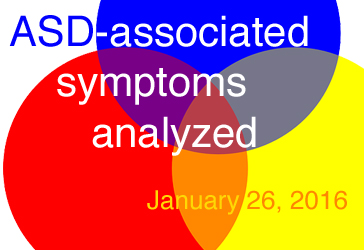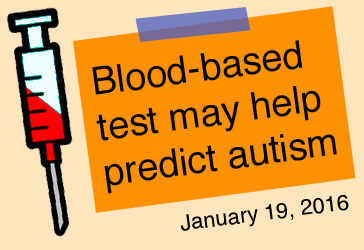Archives
January, 2016
Select a different month in the archive
Follow-up of symptoms associated with autism
By Shana R. Spindler, Ph.D. on January 26, 2016

Background: Previous studies have shown that Autism Spectrum Disorder (ASD) is frequently associated with a number of health conditions in addition to the core symptoms of social communications and repetitive behavior. The rate and time course of these co-occurring symptoms, such as sleep disturbances or gastrointestinal (GI) problems, have not been fully analyzed.
What’s new: In the February 2016 issue of Research in Autism Spectrum Disorders, researchers from the National University of Ireland published a two-year follow-up study to examine co-occurring conditions in 56 children and adolescents with ASD. They found that sleep problems and GI symptoms persisted in about 91 percent and 84 percent of the participants, respectively. High rates of sleep problems co-occurred in individuals with bloating, nausea, abdominal pain, diarrhea, and/or constipation.
The researchers found that almost 93 percent of the participants had a family history of autoimmune disorders. Individuals with a history of thyroid disorders had greater GI symptoms, while a history of ulcerative colitis or Crohn’s disease associated with depressive symptoms, repetitive behavior, and sleep duration.
Why it’s important: This is the first study to investigate several comorbid conditions over two years. The results suggest a link between autoimmune disorders, GI symptoms, and sleep problems in children and adolescents with ASD, but additional research is needed to make any conclusions.
Help me understand :
| Source(s) : |
| Tweet |
Possible Blood Biomarker for ASD in Children Found
By Chelsea E. Toledo, M.A. on January 19, 2016

Background: Early intervention in children with autism spectrum disorder (ASD) is known to improve behavioral outcomes. Biomarkers – such as proteins in the blood or patterns of activity in the brain – may help identify children with the disorder earlier in infancy, allowing for earlier intervention. Currently, physicians do not have reliable biomarkers to use in the clinic to predict the onset of ASD in children.
What’s New: On January 14, 2016, the journal Scientific Reports published a study that detailed a possible biomarker in the blood of children with ASD. The researchers compared the blood serum from 74 boys between 2 and 10 years old with ASD, 60 of their typically developing peers, and 53 adult males between 40 and 75 years old. Using a large collection of synthetic chemical chains made in the laboratory, they found that one chain in particular, called ASD1, bound to a serum antibody with far greater frequency in typically developing boys than in those with ASD. Interestingly, the results with the ASD children resembled those of the older male group. This difference in activity allowed the researchers to identify ASD cases with 66 percent accuracy.
Why it’s important: This study builds on previous research that suggests that the immune system is different in people with ASD. Immune activity in children with ASD may resemble that of older individuals. According to the authors, measurements with ASD1, in combination with other blood-based measurements (such as hormone levels), could lead to a blood test for ASD with higher predictive accuracy for clinical use.
Help me understand :
| Source(s) : |
| Tweet |
Children of Blind Parents Reveal Clues About Eye Contact
By Chelsea E. Toledo, M.A. on January 12, 2016

Background: Children with Autism Spectrum Disorder (ASD) have been known to avoid eye contact. Studies have demonstrated that children who eventually receive a diagnosis can display differences in eye contact as early as six months of age. Researchers have hypothesized that this tendency could impact the development of areas in the brain related to social behaviors.
What’s New: On November 19, 2015, the journal Current Biology published a study of sighted children born to blind parents. The researchers used eye-tracking technology to explore how 14 infants between the ages of 6 and 10 months engaged with adult faces, repeating the experiment 6 months later. When compared to a group of infants born to sighted parents, children born to blind parents paid less attention to adults’ eyes – as seen in similarly aged children with ASD. However, the children of blind parents demonstrated otherwise typical development, and even excelled at visual attention and memory.
Why it’s important: This study shows that typical children adjust their behavior as they adapt to their environments and social cues. If a parent uses eye movements, rather than words and gestures, to signal important objects, then a child will focus more on the parent’s eyes. Future studies could address if core ASD traits stem from a child’s inability to adapt to his or her early environment appropriately.
Help me understand :
| Source(s) : |
| Tweet |

